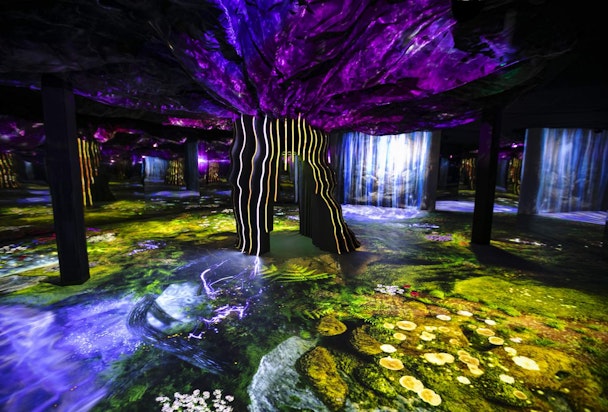How to make a memorable, measurable immersive experience
As part of The Drum’s Experiential Marketing Deep Dive, Tom Burch of Pixel Artworks, the creative production company behind epic experiences for the likes of Adidas, Disney and The Macallan, outlines the multiple layers that make up a truly memorable immersive experience.

Experiences have changed forever. As we hurtle towards the end of 2021, they can no longer afford to be one dimensional. The most effective are made up of multiple layers. And it is in layering these that makes it possible to create and deliver memorable, measurable immersive experiences that exceed consumer expectations. Here’s how…
Adoption of immersive technology
Post-Covid, 76% of Gen Z still want physical and in real-life experiences alongside their digital counterparts – the demand is there. Built on a bed of innovation developed through the pandemic, immersive experiences are now undergoing their hastened transformation. As digital and screens have become ubiquitous, brands are increasingly adapting to immersive technologies to attract audiences to IRL experiences. Lego has just opened its US flagship store, providing consumers a whole new way to experience the brand. Visitors can sit in a life-sized Lego taxi or engage in an interactive, immersive Brick Lab experience. Immersive technology is at its heart – right where it should be – drawing people into the physical space through pre-booked tickets to the experience.
The prevailing appetite from brands, driven by consumer demand and expectation from the arts world, is towards more and more complete or total immersion. Genesis at the Chengdu Auto Show was a piece of art. By creating a next-level stand design including two inspiring experience touchpoints, the Genesis Galaxy Room and the G70 ‘Design your Dynamism’ experience provided a true immersive feel, making people feel part of an alternative environment. Brands need to leverage this space, where their audience are fully engaged.
Gamification of experiences and real-time content creation
Once immersed in an environment, you have the audience’s undivided attention. The challenge is keeping it. This is where we can learn from the games industry – not only in terms of gamification and creating incredibly high dwell times, but also real-time content creation. This is becoming more accessible thanks to extended reality (XR) and virtual production converging gaming and production industries.
Brands can also implement real-time technologies to make remote global audiences feel more engaged. The Omen Challenge by HP Omen is a great example of taking this even further and merging the physical and digital within an esports tournament. Players competed in a game level that was designed around the venue where the tournament was hosted. Using real-time technology and XR streaming, players could physically stand in the gaming level and replay their latest kills. Remote audiences were able to see, review and question the gamers throughout the stream, which attracted nearly 500,000 viewers.
Augmented reality and first-generation wearables
Now, more than ever, consumers are open to using technology to enhance their experience. That ‘adaption’ might have been triggered by the absence of a menu in a restaurant, but now the bridge between mobile handset and immersive digital experience is finally possible and increasingly seamless.
The adaption of QR codes to join an AR experience is revolutionizing the use of AR in everyday life. This resolved one of the previous main friction points for connecting devices to immersive experiences. Additionally, the handset experience can be tailored for fun, fact or fiction and data can be tracked and measured. Not only this, but the experience can be enjoyed in part or replicated at home. Immersive digital experiences and digital AR worlds are converging and colliding – it’s going to be epic.
Connected content experiences
It’s one thing creating an experience but it’s crucial to create highly shareable connected content to fill digital platforms and channels with. The dream with connecting the customer handset to the immersive experience is that you’re also starting a digital journey. Covid showed us that we didn’t really need shops to spend – digital did the job. Therefore, the lure of IRL immersive experiences, with an added layer of AR, is to not only elevate what could be achieved online but become the next gateway to a brand’s digital journey. It opens the door to a new connected content ecosystem.
The recent announcement by Facebook and Apple tells us that it won’t be long until the first generation of wearables will be out, and that’s why we’re investing in connected AR experiences from within. The peripheral vision of first-generation AR glasses will be limited, inevitably, which is why immersive experiences and AR wearables will first land together, to create truly immersive, connected content experiences.
Measurement
Pre-Covid, the terms around experiences were ‘cool’, ‘big’ and ‘unseen’. Now our focus is ‘measurable’. It’s crucial for brands to know how effective their immersive experiences are.
Metrics need to start with tangible measurability and then add the value created through digital channels. With experiences such as the Sundown Spectacular at Warwick Castle, and attractions like ‘The Awakening’ at St Michael’s Caves in Gibraltar reopening post-Covid, it’s proof that experiences can drive ticket sales and tangible measurability.
As we enter this new era of experiential marketing, brands must constantly be striving to meet consumers’ expectations. By planning through the lens of these five layers, brands can build experiences that are going to create long-lasting and meaningful connections.
Tom Burch is managing director of Pixel Artworks.
